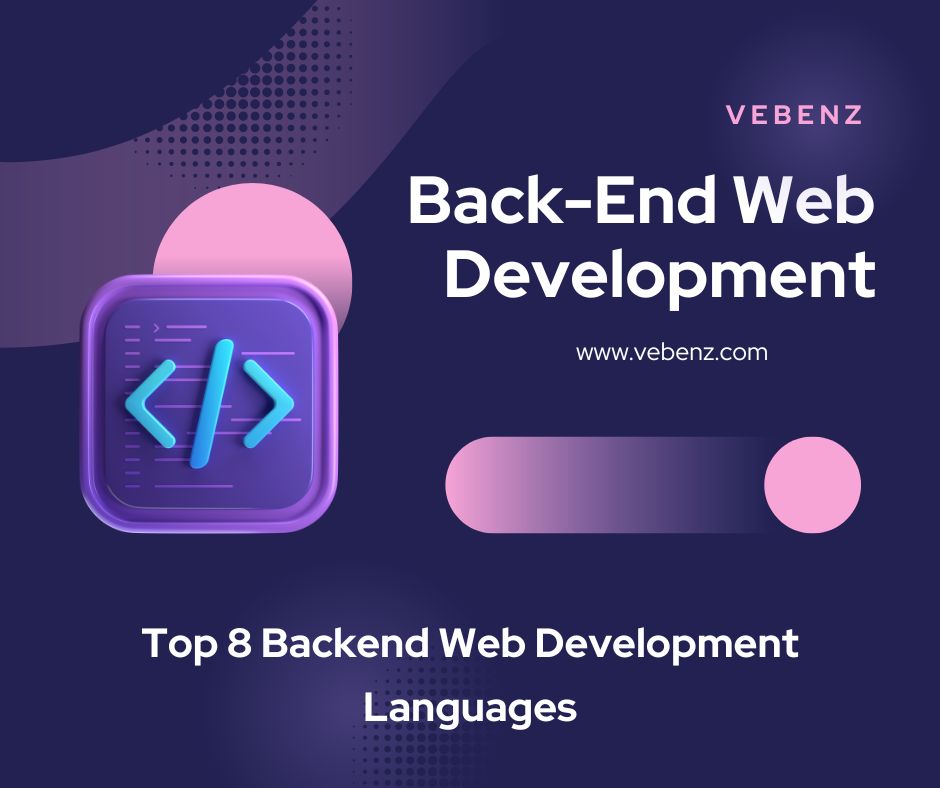Knowing multiple programming languages is the best way to keep up with the industry and stay ahead of your competition. These days, most projects are based on some sort of web technology. Therefore, knowing how to code in a variety of languages is crucial.
Top 8 Backend Web Development Languages
As a back-end developer, you’ll be expected to know at least one or two back-end languages (PHP, Python) along with at least one front-end language (JavaScript or HTML/CSS). If you can do this well enough for all projects then your employer will be thrilled!
1. PHP
PHP is a server-side programming language that is easy to learn, easy to use, and runs on any operating system. It’s also the most widely used web programming language in the world.
PHP was originally developed by Rasmus Lerdorf for his personal website in 1995. Since then it has become one of the most popular languages used for creating dynamic web pages with databases or scripts that interact with websites online.
2. Python
Python is a general-purpose programming language, created by Guido Van Rossum in 1989. It’s used for back-end web development, data science and machine learning, artificial intelligence (AI), scientific computing, and other technical fields.
Python is also used to build desktop applications like games or virtual reality experiences on the web (e.g., through Unity).
3. C#
C# is a general-purpose programming language developed by Microsoft. It was first released in 2000 and has been widely used in the .NET Framework and .NET Core. C# is designed to be easy for application developers to learn, which makes it suitable for use in back-end web development projects.
C# has three main features that make it ideal for this kind of work:
- It’s object-oriented (OO) – This means you can create classes that represent objects like cars or people; these classes are called types because they have different types of data associated with them (e.g., an object might have an address). OO programming allows you to create software with reusable components instead of just writing everything from scratch each time you need something new!
- It’s LINQ – LINQ stands for Language Integrated Query, which lets developers query databases using queries based on their own existing code instead of having to write SQL queries from scratch every time they want data from a database table or other source type (like JSON). This saves time because instead of creating complex SQL statements yourself manually every time there’s something interesting about what’s happening inside your program—you just use LINQ syntax directly within your code base itself!
4. Java
Java is a general-purpose programming language that is concurrent, class-based, object-oriented, and specifically designed to have as few implementation dependencies as possible. Java was developed by James Gosling at Sun Microsystems in 1991 with a philosophy of “write once run anywhere”. It has since become one of the most widely used programming languages in history.
Java can be used for back-end web development due to its extensive support for cross-platform development: it has been ported to every major operating system and Web browser since its first release in 1996 (including Windows NT 4).
5. Ruby
Ruby is a dynamic, object-oriented programming language. It’s used by many web developers and has been for many years. Ruby is often regarded as being easier than languages like Python or JavaScript because of its more straightforward syntax and less verbose code.
Ruby also has an abundance of libraries that can be used to do various things in the back end of your application. These include:
- Nginx – a web server that routes requests according to their destination IP address (it doesn’t care about HTTP requests)
- Mongrel/ActionCable – an asynchronous framework that allows you to run multiple threads simultaneously while maintaining almost zero overhead on each thread itself
You should definitely consider using it if you’re looking at creating something similar!
6. JavaScript
JavaScript is a client-side programming language that’s used to make websites more interactive and responsive. It can also be used for server-side web development, but at the end of the day, it is still extremely useful when building back-end applications.
JavaScript is one of the most popular languages in use today because it allows you to create dynamic websites with ease—and this makes it perfect for back-end development!
7. Rust
Rust is a systems programming language. It’s designed to run efficiently on servers, in embedded devices, and in other high-performance applications.
Rust is memory safe by default, which means that you don’t have to worry about memory safety bugs when using the language. The compiler will check for these issues before compiling your code and make sure it doesn’t create any problems for other users of your software or hardware.
Read: 8 Top Languages to Use in Back-End Web Development in 2022
The compiler also performs optimizations such as dead code elimination (eliminating unnecessary parts of programs), loop unrolling (reducing overhead), and tail call optimization (allowing more efficient use of stack space). These optimizations help improve performance without sacrificing readability or reliability—a huge benefit if you’re working on systems where these types of things matter!
8. Go programming language
Go is a general-purpose programming language that was created by Google. It’s based on the idea of a “simple” language, with no exceptions or special cases. The only feature of the language that makes it stand out from other languages is its type system, which provides strong typing and prevents runtime errors.
Go has been used to build many large software products such as Docker, Kubernetes and their related tools; Linux kernel subsystems; various kinds of compilers (GCC or LLVM); web servers like Nginx/PHP; database engines such as Redis for key-value stores or MySQL for relational databases, etc.
Being proficient in multiple programming languages is a great way to jump ahead of your competition. You can use these languages to build a website, mobile app, or server.
If you’re looking for an opportunity to learn more about back-end development and how it works, then take a look at some of these options:
- Ruby on Rails (Ruby) – This language is used by developers who want to use Rails or similar frameworks on their web apps. It has become one of the most popular ways for companies like Pinterest, Groupon, and Airbnb to build websites using this framework
- Python – This programming language has been around since 1991 but still continues to be popular among developers because it’s easy enough for beginners but powerful enough for professionals
Conclusion
If you’re still not sure which language to use for your next project, then consider these top languages. We have taken into consideration different factors like the popularity and use of each language along with the number of job listings that are available for developers who know them well.


